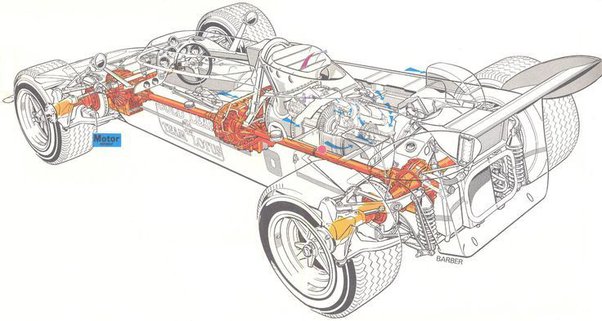In the high-octane world of Formula 1 racing, the intricacies of car technology play a crucial role in shaping the outcomes on the track. One key area of discussion amongst enthusiasts and experts is the type of drive system used in these cutting-edge machines. Formula 1 cars, known for their speed, agility, and precision, use a rear-wheel drive (RWD) system, as mandated by the regulations set forth by the FIA, the sport’s governing body.
This choice in drive system is not arbitrary; it’s deeply rooted in the sport’s history and driven by the continuous pursuit of optimal performance.
While all-wheel drive (AWD) systems offer certain advantages like enhanced traction, especially in road cars, they are not employed in Formula 1 due to specific reasons tied closely to the objectives of the sport. The emphasis on minimizing weight, reducing complexity, and maintaining the delicate balance of power and handling has led to teams universally adopting RWD for their vehicles. AWD systems, though capable of providing better grip in some scenarios, would introduce additional weight and complexity that could detract from the inherent performance characteristics Formula 1 teams work to refine.
Key Takeaways
- F1 cars utilize a rear-wheel drive (RWD) system in lieu of all-wheel drive (AWD).
- The FIA’s regulations and the quest for optimal racing performance dictate the use of RWD.
- AWD, despite certain advantages, is unsuitable for F1 due to increased weight and complexity.
History of Drive Systems in Formula 1
Formula 1 has predominantly been a proving ground for rear-wheel drive (RWD) vehicles, with a brief period of experimentation with all-wheel drive (AWD) systems during the 1960s. This section explores the early introduction and developmental milestones of AWD technology in the motorsport.
The Emergence of AWD in F1
In the 1960s, Formula 1 witnessed the introduction of AWD technology. The Ferguson P99 became the first AWD car to win a Formula 1 race, albeit a non-championship one, in the 1961 British Empire Trophy. This marked the beginning of AWD experimentation, with the belief that AWD could offer better traction, especially in challenging conditions.
Notable AWD Developments and Teams
Several teams, including Lotus, Matra, and BRM, explored AWD. Specifically, the Lotus 63 was a technical response to the increase in power outputs that cars of the era were beginning to harness. Designed by Colin Chapman, the Lotus 63 aimed to utilize AWD to manage the power more effectively. However, it ultimately failed to make a significant impact in the competition.
Matra and BRM also developed AWD F1 cars during this period, experimenting with different configurations to exploit the potential advantages of improved grip. Despite their efforts, these AWD systems were complex and heavy, leading to reliability issues.
Meanwhile, Cosworth’s introduction of the DFV engine in 1967 shifted the paradigm. The engine’s powerful and lightweight design demonstrated that a finely tuned RWD car could handle the power more efficiently than its heavier AWD counterparts. The additional weight and complexity of AWD systems did not justify their benefits, causing teams to revert to RWD setups. The AWD system found in these early F1 cars eventually fell out of favor, as the RWD platform offered a better balance between performance, weight, and simplicity.
Technical Aspects of F1 Cars
Formula 1 cars leverage sophisticated engineering to master the complex interplay of traction, power delivery, and handling. The rear-wheel drive (RWD) configuration they employ stands at the core of this balance.
Engineering Behind RWD and AWD Systems
Rear-wheel drive (RWD) systems are a hallmark of Formula 1 car design. They channel the engine’s power exclusively to the rear wheels, offering a balance of performance, weight distribution, and mechanical simplicity. All-wheel drive (AWD) systems, in contrast, distribute power to both the front and rear wheels. While AWD can improve grip and acceleration under certain conditions, its additional weight and complexity render it unfit for the specific demands of F1 racing.
| Aspect | F1 RWD Configuration | AWD Systems |
|---|---|---|
| Power Distribution | Rear wheels only | All four wheels |
| Complexity | Less complex | More complex |
| Weight | Lighter | Heavier |
| Use in F1 | Standard | Not used |
Dynamics of Traction and Handling
Traction is the cornerstone of a Formula 1 car’s acceleration and cornering ability. With RWD, traction is concentrated on the rear wheels, which are responsible for propelling the car forward. This focus allows for a more precise management of tire grip during high-speed maneuvers. In terms of handling, RWD facilitates a fine-tuned balance, enabling drivers to steer the car with the throttle through corners. AWD, while potentially offering more traction, would distribute this control among all four wheels, which could actually detract from the delicate balance required for Formula 1 racing.
Performance Implications
The drive system of a Formula 1 car has critical implications for its speed and aerodynamics, as well as how these factors interplay with the vehicle’s overall performance. The choice between all-wheel drive (AWD) and rear-wheel drive (RWD) affects aspects ranging from downforce to cornering agility.
Speed and Aerodynamics
In Formula 1 racing, speed is paramount, and achieving the highest speeds requires minimizing aerodynamic drag. Rear-wheel drive (RWD) is preferred because it allows for a more aerodynamically efficient design.
An AWD system would introduce added frontal area and components that could increase the drag, which is detrimental to top speed. Moreover, engineers must optimize for downforce — the force pushing the car down onto the track, which enhances tire grip and cornering performance without unduly increasing drag.
Comparing AWD and RWD in F1
While AWD might offer improved traction, particularly in low-grip conditions, the added weight and complexity do not favor the performance criteria of Formula 1.
RWD configurations offer several advantages:
- Weight Distribution: RWD allows for optimal weight distribution, crucial for handling and acceleration.
- Tyre Size: F1 vehicles feature larger rear tires compared to the front, aiding in traction during acceleration. This design is facilitated by RWD.
- Cornering Performance: RWD ensures better cornering performance due to the lighter and simpler drivetrain, which leads to improved agility on the track.
Overall, the careful balancing of speed, downforce, and aerodynamic efficiency is central to F1 car design, with RWD systems consistently proving to be the optimal choice for these high-performance machines.
Regulations and Legality
In the world of Formula 1, the regulations defined by the Fédération Internationale de l’Automobile (FIA) are the ultimate authority on vehicle specifications, including drive systems. This section outlines the FIA’s stance and the evolution of rules governing the legality of drive systems in the sport.
FIA’s Stance on Drive Systems
The FIA has been clear in its prohibition of all-wheel drive (AWD) systems in Formula 1 cars. Since 1982, the organization’s regulations have mandated that cars be propelled by no more than two wheels—typically the rear ones. This regulation helps maintain a level playing field and curtails the development of advanced, high-cost AWD technologies that could skew the competition.
- Drive Systems allowed by FIA:
- Rear wheel drive (Traditional)
- Two-wheel drive only
Past and Present Rules
Historically, Formula 1 cars were not restricted in terms of the drive system. However, the shift in rules emerged in the early 1980s following concerns over cost and complexity. Today, these guidelines remain enforced, ensuring that teams focus on refining two-wheel drive systems rather than exploring prohibited AWD options.
- Timeline of Drive System Rules:
- Before 1982: No specific restrictions on drive systems
- 1982 Onwards: Implementation of two-wheel drive only rule
Advantages and Challenges of AWD

All-wheel drive (AWD) systems provide enhanced traction and handling, but they come with a set of technical complications and higher resource demands.
Benefits in Motorsports
In motorsports, AWD can offer numerous benefits. They typically provide superior grip over rear-wheel drive (RWD) systems, particularly in adverse conditions such as wet or slippery tracks. With power distributed across all four wheels, AWD vehicles can achieve faster acceleration out of corners. These systems can also enhance stability and handling, making them favorable in high-performance racing scenarios.
- Improved Traction: All tires contribute to propelling the vehicle, optimizing grip.
- Stability and Handling: Better weight distribution across all tires improves steering response.
Drawbacks and Technical Challenges
Despite the advantages, AWD platforms pose several challenges. They are inherently more complex and heavy than two-wheel drive systems, which can lead to decreased fuel efficiency and higher costs — both in initial manufacturing and ongoing maintenance. The additional drivetrain components can also affect reliability, as there are more potential points of failure.
- Increased Weight: More components add to the vehicle’s mass, potentially reducing acceleration and top speed.
- Cost and Complexity: The intricate system raises production expenses and maintenance requirements.
- Fuel Consumption: Additional power needed to engage all wheels can lead to higher fuel usage.
By carefully balancing these factors, automakers must decide whether the performance benefits outweigh the efficiency and cost hurdles.
Impact on F1 Racing Strategies
Formula 1’s commitment to rear-wheel drive (RWD) vehicles shapes race strategies around the specific skills of the driver and the adaptability to various weather conditions.
Driver Skills and Racecraft
Drivers in F1 require a high level of skill and racecraft to effectively handle RWD cars, especially when it comes to precision steering, throttle control, and managing the rear traction during cornering and acceleration. Their ability to optimize the use of the available grip directly influences their success on the grid. In dry conditions, the rear-wheel drive configuration demands a delicate balance of power and control, which has a profound impact on overtaking maneuvers and tire management.
The Role of Weather Conditions
In wet conditions, the strategic approach changes significantly. Drivers must adapt their styles to manage the reduced grip levels, and teams may adjust car setups to suit the slippery conditions. They strategically choose tire compounds that can disperse water efficiently, ensuring that aquaplaning risks are minimized. The unpredictability of weather conditions often leads to varied grid positions, impacting the future race outcomes as drivers and their teams must constantly adapt their strategies to the evolving track conditions.
The Future of Drive Technology in F1
As Formula 1 progresses, the potential integration of All-Wheel Drive (AWD) systems and advanced technology could redefine the competitive landscape and alter the dynamics of racing teams.
Innovations and Potential AWD Adoption
The exploration of advanced drive technologies indicates that AWD systems, which provide power to all four wheels simultaneously, may eventually find their role in F1. Historically, F1 cars have been Rear-Wheel Drive (RWD) due to regulations and the desire to minimize weight, but with the relentless push for technological advancement and increased performance, teams are continually assessing the potential benefits of AWD. If regulations adapt to allow AWD, this could see teams investing heavily in the research and development of such systems to gain a competitive edge.
Impact on Racing Teams and Competition
The introduction of AWD systems in Formula 1 would necessitate a significant adaptation by racing teams. It would lead to a shift in:
- Vehicle Dynamics: Changes in weight distribution and handling.
- Engineering Resources: Enhanced focus on developing AWD technologies.
- Strategic Planning: Adaptations to race strategies due to altered car performance.
This technological shift could create a fresh competitive landscape, driving teams to redefine their success parameters and pushing them to innovate, with potential impacts on the outcomes of races and championships.
The success of racing teams in this new environment would hinge on their ability to master AWD systems and effectively integrate them into their vehicle designs while adapting to a possibly restructured set of competition regulations.
Frequently Asked Questions
This section addresses common queries regarding the drivetrain configurations of Formula 1 cars, clarifying why they are designed with a specific system and discussing the regulations and history related to their drivetrain choices.
Why do Formula 1 cars use rear-wheel drive instead of all-wheel drive?
Formula 1 cars utilize rear-wheel drive (RWD) to maximize performance and reliability. The RWD setup provides optimal handling and acceleration benefits critical for high-speed racing.
Is the use of all-wheel drive systems permitted in Formula 1 regulations?
No, all-wheel drive systems are not allowed in Formula 1. The sport’s regulations specify that cars must be rear-wheel drive to ensure a measure of standardization and performance balance.
Have there been any Formula 1 cars with four-wheel drive in the sport’s history?
In the history of Formula 1, there have been instances of four-wheel drive cars, particularly in the early years. However, these designs were not successful and were eventually phased out in favor of rear-wheel drive vehicles.
What are the reasons for Formula 1 cars not being equipped with all-wheel drive?
Formula 1 cars are not equipped with all-wheel drive due to the additional weight and complexity such systems would introduce. These factors would negatively impact the speed and handling of the cars.
How does the drivetrain of a Formula 1 car differ from typical AWD vehicles?
A typical all-wheel drive (AWD) vehicle distributes power to all four wheels, which can be beneficial for traction in various conditions. In contrast, a Formula 1 car’s RWD drivetrain delivers power exclusively to the rear wheels, which is optimized for traction and control at high speeds on racing circuits.
What technological advancements have Formula 1 cars made in lieu of all-wheel drive?
Instead of all-wheel drive, Formula 1 cars have developed advanced technologies such as sophisticated aerodynamic designs, traction control systems, and tire advancements to improve grip, stability, and performance on the track.





